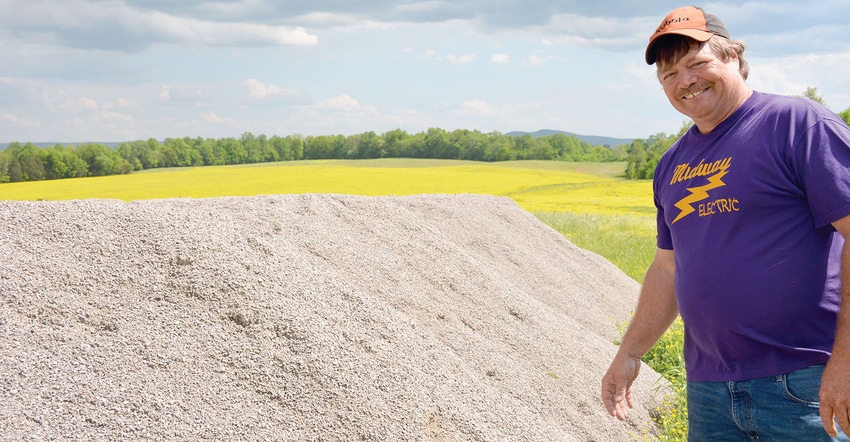
Terry Bell has a lot of irons in the fire — 1,000 acres of row crops, a tree nursery, a busy family, and he’s running for the office of county executive in Warren County, Tenn.
“At one time, we were a dairy farm,” Bell says as a way of explaining that long days are just par for the course. He’s been a county commissioner for several years, too.
“I am glad to have my sons coming back to the farm,” Bell said from a shady spot in his mother’s front yard on a clear, warm day in early May. Sons Tyler, 26, Trevor, 22, and Travis, 18, all work on the farm. The older two have bought acreage on their own, all adjacent to the home farm. Travis graduates from high school this year and is joining his father and brothers.
“They have never wanted to do anything else but come back and farm,” Bell says.
“I worked with my dad, and he worked with my grandfather, and my sons are working with me. They will be the fourth generation to farm here.” A daughter, Rachel, 15, hopes to go into nursing.
He says his wife, Beckee, is a vital part of the operation, too. “She and my mother used to run a restaurant we owned. My dad used to say that a restaurant was the one business that was worse than a dairy.”
Trees labor-intensive
The diversified farm needs the hands. “We work the trees and the crops with just us and a few laborers from the H2A program,” Bell explains. Trees are labor-intensive for much of the year.
They started growing trees after getting out of the diary business. “Dry spells in the 1980s almost wiped us out. That’s when we turned to trees,” he says. “We peddled off the back of a pickup at first, but found buyers in Knoxville and started brokering for other growers in the area.”
He says niches such as trees play an important role for small farmers. “They took a lot of things away from farmers,” he says, including profitable dairies and hog operations.
Row crops play an important role, too, and spread enterprise risks. “We got heavy back into row crops in 2010,” Bell says. He prefers a half corn and half soybean rotation on the 1,000-acre row crop operation. “But this year, I can’t pencil out a way to make corn pay. We will plant all beans.”
He says his grandfather got started in soybeans “back in the ’60s. He got $3 a bushel and thought that was a great opportunity.”
Soybeans still offer a good option for the Bells, especially if they get them out early. “We plant to harvest early. We can get a 30-cent bump over basis if we get them out before mid-September.” He spreads maturity groups – 3.8 to 4.8 — and wants to be finished harvesting by early October.
Storage bins
He can get a bump on corn, too, by holding it past harvest. “We have two, 27,000-bushel storage bins,” Bell says. “We can sometimes pick up an additional 40 cents a bushel if we hold corn until March.”
Even without the bump, he says the bins offer significant benefits at harvest. “If we have to load trucks out of the field and haul to the elevator, we spend two to two-and-a-half hours out and back. With our storage, we can be back in the field in an hour.”
By early May, he had more than 200 acres of group 3.8 beans planted. “I always want to be done by June, but I prefer to be finished planting by Memorial Day.” He says spreading maturity groups reduces risk — weather and market. “I don’t want them to be all the same type.”
Bell farms rolling land, some rather steep slopes, and says no-till makes it possible. “The only time I work the ground is if I have a hard time combining and tear up the soil. Some wet lands may need to be smoothed out a bit.
“We quit row crops for a while,” Bell says. “When Roundup Ready came along, we went back to raising crops.”
He likes to grow corn to get the residue into the soil, and he likes to follow soybeans with corn. “We see a 5- to 10-bushel yield jump with corn after beans,” he says. Part of that may be the nitrogen advantage from the beans.
Fertilizer
“We still put 225 pounds of nitrogen, 96 of phosphorus and 120 of potassium on corn. Soybeans get a ratio of 18-69-120 fertilizer.
“We apply most just before we plant,” Bell says, “but we have applied phosphorus and potassium in the fall. We soil test every year, and if we need to balance one field or another, based on soil test results, we do that.
“We also use a lot of lime. If the pH is not right, the plant will not take up nutrients. Sometimes it’s better to add lime than to buy more fertilizer.”
Yields have been good.
Bell says corn last year averaged from 175 to 180 bushels per acre, all dryland. “We had some fields that made 200, but we also had some that made 140 to 145.”
He says one field of soybeans made 75 bushels per acre last year. “That was the best field and the first of the group 3 beans. Early beans averaged 68 bushels per acre. Farm average was 52 to 55 bushels per acre. My middle boy wants to make 100-bushel soybeans.”
He says that goal will require significant inputs. They already pay close attention to in-season management. “We used a fungicide on the 75-bushel soybeans and foliar fed two times. We applied an insecticide every time we went over the field. At $1 per acre for the insecticide, it’s easy to justify.”
Insect pests
He says stink bugs and aphids are the primary insect pests.
Bell’s corn acreage typically receives similar management. “But I haven’t found an advantage with fungicides in corn. And insects are not as much trouble.”
Row crop planting and harvest seasons mesh with downtime in the tree operation. Bell says they typically quit digging trees in May, before they leaf out. He pointed out new growth on a dogwood being prepared for transport on May 7. “If this limb was about this much longer,” he said, showing about a 2-inch gap between his thumb and forefinger, “the leaves would curl up on us.” That’s not what a buyer wants.
As tree harvest winds down, row crop planting gears up. And he wants to finish with row crop harvest by mid- to-late fall, before tree harvest season picks up again.
He says the tree market is a bit more stable than corn or soybeans, although it is closely aligned with the housing market. The 2008 downturn was a tough stretch. “If you drive around and don’t see any building activity,” he says, “the tree market will be hurting soon.”
He says his best tree market is for “anything that’s not a pear. At one time, we made a living selling pear trees and sold 4,000 a year. We’re down to 1,600 and in Ohio the (ornamental) pear trees are listed as invasive species.”
Across his tree nursery acreage, he has plots of maples, elms, cherry, dogwood and various other shade tree species. Most trees go to market quickly. “Pear trees would move out in two years,” Bell says. “Others, we hold for three or four years before we make money from them, and some we’ve kept for eight or 10 years.”
Care with herbicides
Bell says growing trees and row crops in close proximity offers challenges, especially with herbicide application. “We have to be careful. We have not used any 2,4-D in years,” he says. “I did once and burned some trees, so we don’t use it at all.” He says a small mistake with herbicide application can result in a $25,000 to $30,000 loss on a “small block of trees.”
Bell drove around the fields close to headquarters. He leases acreage farther out, some as far as 25 miles from the home farm. He shows a field of soybeans just emerging, stops to watch his middle son dump a truckload of lime into a field to be spread later, and makes a final stop where his other two sons, with some hired hands, were digging, wrapping and loading dogwoods.
The work was hard and dirty. A sudden rainstorm had left the fields wet and muddy, but Bell and sons greeted each other and the photographer with smiles and good-natured ribbing. “This is a family farm,” Bell says. “It always has been.” And will be for at least one more generation.
About the Author(s)
You May Also Like






